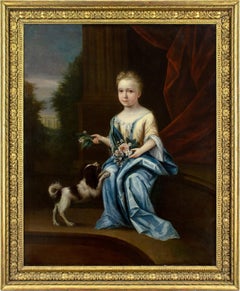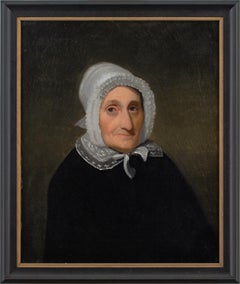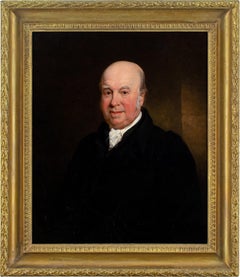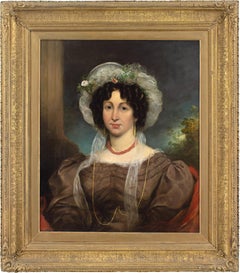Video Loading
Want more images or videos?
Request additional images or videos from the seller
1 of 14
Unknown16th-Century Dutch School, Portrait Of Gaspard De Coligny, Admiral of Francec. 1575
c. 1575
$3,966.36List Price
About the Item
- Creation Year:c. 1575
- Dimensions:Height: 27.5 in (69.85 cm)Width: 25 in (63.5 cm)
- Medium:
- Movement & Style:
- Period:
- Condition:Cleaned. Fine craquelure throughout. Various areas of historic restoration, pitting, darkening, multiple canvas relines. The paint layer is stable. Frame with various marks, repairs and alterations, and generally showing its age.
- Gallery Location:Cheltenham, GB
- Reference Number:1stDibs: LU2328215181182
About the Seller
5.0
Platinum Seller
Premium sellers with a 4.7+ rating and 24-hour response times
Established in 2017
1stDibs seller since 2023
246 sales on 1stDibs
Authenticity Guarantee
In the unlikely event there’s an issue with an item’s authenticity, contact us within 1 year for a full refund. DetailsMoney-Back Guarantee
If your item is not as described, is damaged in transit, or does not arrive, contact us within 7 days for a full refund. Details24-Hour Cancellation
You have a 24-hour grace period in which to reconsider your purchase, with no questions asked.Vetted Professional Sellers
Our world-class sellers must adhere to strict standards for service and quality, maintaining the integrity of our listings.Price-Match Guarantee
If you find that a seller listed the same item for a lower price elsewhere, we’ll match it.Trusted Global Delivery
Our best-in-class carrier network provides specialized shipping options worldwide, including custom delivery.You May Also Like
Portrait of a Lady with Jewels Dutch School 18th century Signed with Frame
Located in Pistoia, IT
Portrait of a woman with jewelry, early 18th-century Dutch school by painter Gérard Wigama (1673-1741). Monogram in the lower right corner on the base of the GW column. Fine Arts exp...
Category
1720s Dutch School Portrait Paintings
Materials
Canvas, Oil
$10,166
H 30.71 in W 25.6 in
After Rembrandt "The Prodigal Son in the Tavern" Old Master Style Painting
Located in San Francisco, CA
After Rembrandt
"The Prodigal Son in the Tavern"
Old Master Style Painting
Late 19th century - Early 20th century
Oil on Canvas
36.75 x 44.5 unframed
40.5" x 48.5" framed
Category
Late 19th Century Dutch School Portrait Paintings
Materials
Canvas, Oil
$9,450
H 48.5 in W 40.5 in D 3 in
Boy with a flute
By Leon Herbo
Located in Gent, VOV
Léon HERBO (1850-1907), Young boy with a flute, oil on canvas, signed upper left and dated 1879. This painting seems inspired by the painting "Singing Boy with a Flute" by the Dutch ...
Category
Late 19th Century Dutch School Figurative Paintings
Materials
Canvas, Oil
Portrait of a girl with a rose and a red coral necklace (c. 1631)
Located in Amsterdam, NL
David Finsonius (Veere 1597- Bergen op Zoom 1646/1648)
Portrait of a girl with a rose and a red coral necklace
With traces of the artist’s signature and annotated AETATIS S.V. 2 1⁄2 Ao 1631
Oil on panel, H. 104.5 x 79.5 cm
Provenance:
Purchased by Jonkheer Helenus Marius Speelman (1857-1909), Kasteel de Wittenburg; thence by
descent
The work shows a strong resemblance to a portrait by Finsonius in the North Brabant Museum. This
signed and dated "Girl with Basket and Cherries" (Inv. 15529), was painted just a year later, in 1632.
Not only are the paintings remarkably similar in overall size and format, in painting style, and in the
positioning of the girls in full length in their white lace dresses. They are also connected by the
iconographic scheme of the respective coral necklaces, each with a gold memorial medal hanging
from it. Although they are of course individuals, the faces are very similar in their depictions of
features such as eyes, nose, and lips. This points to the same technique applied by the same painter.
Finally, the handwriting is almost the same on the works by Finsonius known so far.
About the painter, David Finson named 'Finsonius' (related to the better-known Louis Finson...
Category
17th Century Dutch School Portrait Paintings
Materials
Oil, Wood Panel
$101,662
Free Shipping
H 41.15 in W 31.11 in D 1.58 in
Dutch Girl Contemporary Portrait of a Child
By Kiki Lamers
Located in Brookville, NY
Woman artist Kiki Lamers portrait of a Young Girl is Signed and dated with title on the reverse the painting "Dutch Girl" by Kiki Lamers is framed in a silv...
Category
1990s Dutch School Portrait Paintings
Materials
Oil
Diana the huntress with her dogs
Located in BELEYMAS, FR
Barend GRAAT
(Amsterdam 1628 – Amsterdam 1709)
Diana the Huntress
Oil on wood
H. 33.5 cm ; L. 44 cm
Signed lower right on the stone
A discreet painter with respect to history, Baren...
Category
1670s Dutch School Nude Paintings
Materials
Oil, Wood Panel
Knitting woman by Anne Marie Mulder - Oil on canvas 30x40 cm
Located in Geneva, CH
Oil on canvas sold with frame
Total size with frame 48x58 cm
Anne Marie Mulder was born in 1921. After secondary school she trained at the national Academy of Visual Art in Amsterd...
Category
Mid-20th Century Dutch School Portrait Paintings
Materials
Oil
$1,520 Sale Price
20% Off
H 15.75 in W 11.82 in D 0.79 in
'Traveller in a Duch Village' by Jan Meerhoud (1633 – 1677) Dutch - Golden Age
Located in Knokke, BE
Jan Meerhoud
Gorinchem 1633 – 1677 Amsterdam
Dutch School
Golden Age
'Traveller in a Dutch Village'
Signature: signed lower left
Medium: oil on panel
Dimensions: image size 21 x 2...
Category
Early 17th Century Dutch School Landscape Paintings
Materials
Oil, Panel
$15,548
Free Shipping
H 13.78 in W 15.75 in D 3.15 in
Bearded man with pipe and hat
Located in Genève, GE
Work on wood
Carved wooden frame
41 x 36.5 x 7 cm
Category
Early 20th Century Dutch School Portrait Paintings
Materials
Oil
The Virgin and Child Enthroned
Located in London, GB
Studio of Adriaen Isenbrandt
1510 - 1551
The Virgin and Child Enthroned
Oil on oak panel, wax seal verso
Image size: 10 3/4 x 8 inches (27 x 20.5 cm)
Contemporary style frame (image below)
POA
Provenance
Collection of Mrs Marianne Hudson
Mary, holding Jesus in her arms, is centrally positioned against a gold detailed architectural backdrop, reflecting the traditional iconography of the enthroned Virgin and Child. This composition suggests the theme of “Maestà” or “Majesty,” emphasising the figures religious significance.
In the painting from the studio of Adriaen Isenbrandt, the artist masterfully infuses the scene with rich symbolism and hidden meanings that reflect the cultural and religious context of the period. The infant Christ, seated on the Virgin Mary’s lap, is draped in a delicate, translucent white garment that symbolises his purity. In his hand, he clutches a piece of coral, a multifaceted symbol representing immortality, youth, and health. Notably, coral was also a common teething tool during that era, adding another layer of contemporary relevance.
A scarlet-headed blackbird, native to South America, perches gracefully on Christ’s outstretched finger. This bird is a potent symbol of creation and protection, enhancing the divine narrative of the scene. Mary, with a tender and loving gesture, caresses Christ’s back while gazing adoringly at her son, underscoring her role as the nurturing mother of God.
Mary is centrally positioned within an architectural alcove, which subtly suggests a heavenly halo without explicitly depicting one. The alcove’s niches, traditionally used to emphasise the importance of sculptures, further highlight her significance. She is adorned in a voluminous red gown, with the undulating folds of the fabric accentuated by white highlights. The red colour of her dress symbolises maternal qualities, while the iridescent blue undercoat, visible in certain areas, signifies sanctity and purity due to its rarity and expense at the time.
Moreover, Mary is depicted as the epitome of contemporary Medieval...
Category
16th Century Dutch School Portrait Paintings
Materials
Oil, Wood Panel
More From This Seller
View AllJohn Verelst (Circle), Portrait Of A Young Lady With A Spaniel
By John Verelst
Located in Cheltenham, GB
This large early 18th-century full-length portrait depicts a seated young lady before a classical column and distant country house. It was formerly in the collection of Dalham Hall i...
Category
Early 18th Century Rococo Portrait Paintings
Materials
Canvas, Oil
Mid-19th-Century French School, A Pair Of Nanas, 2 x Oil Paintings
Located in Cheltenham, GB
This charming pair of mid-19th-century French School portraits depicts two grandmothers, both presumably widows, wearing black gowns and white bonnets.
Alas, the identity of these r...
Category
Mid-19th Century Portrait Paintings
Materials
Canvas, Oil
Early 19th-Century English School Portrait Of Samuel Jones Of Skeyton, Norfolk
Located in Cheltenham, GB
This fine early 19th-century English oil painting depicts Samuel Jones of Skeyton, Norfolk, smartly attired in a black coat with white cravat. The portrait was previously in the coll...
Category
1830s Portrait Paintings
Materials
Oil, Canvas
George Clint ARA (Attributed), Portrait Of A Lady In A Brown Dress
Located in Cheltenham, GB
This early 19th-century half-length portrait attributed to British artist George Clint ARA (1770-1854) depicts a young lady wearing a beautiful brown dress, bonnet decorated with small flowers, gold earrings and coral necklace. Clint was a distinguished painter and mezzotint engraver predominantly known for portraiture and dramatic scenes.
Set before an evocative classically-inspired backdrop, she looks out from across the centuries with a composed demeanour. Adorned in the latest fashions, oversized ‘gigot’ sleeves, a delicately-poised bonnet, and a coral necklace for good luck. It’s a charming portrayal by a masterful hand.
Born at Drury Lane, in the heart of London’s West End, George Clint was destined to lead an exuberant life amid the spectacle of theatreland. His father, Michael Clint, was a hairdresser during a time of “hair pomatum, whalebone, wire, lace gauze, and feathers” - so young George would have encountered a variety of ‘characters’ during his childhood.
But despite these elevated surroundings, he soon discovered the darker side of London when thrust into the world of employment. Apprenticed initially as a fishmonger, he trained under a ferocious master who was known to beat him. The hours were unsocial, the conditions rank, and the work was brutal. He soon quit but subsequently found himself toiling for a corrupt attorney who demanded he undertake unscrupulous acts on his behalf.
Seeking a less volatile role, he turned next to house painting, at which he excelled. Commissioned, among other projects, to paint the stones of the arches in the nave of Westminster Abbey. Aside from an incident whereby he almost fell from the second story of a building, all was going well.
Following his marriage in 1792 to Sarah Coxhead, a farmer’s daughter, he began work in earnest as a painter of miniatures, determined to forge a career. Robert William Buss’ memoir celebrates Clint’s success as a miniaturist, stating that “great manual excellence was united with that chaste, delicate feeling for female beauty which characterised all Mr. Clint's portraits of ladies.”
Until this point, it appears he was predominantly self-taught, presumably constrained by a lack of finances. But from hereon in, his industrious nature coupled with several fortunate encounters, led to him developing an enviable talent for both painting and engraving. During the early 19th-century, the acquaintances one kept could make or break your fortunes and perhaps acutely aware of this, Clint’s ‘society’ was an ever-evolving circle of influential personalities.
He was “initiated into the mysteries of engraving” by Edward Bell (act.1794-1819) and produced numerous works after the foremost artists, such as George Stubbs, John Hoppner, and Thomas Lawrence. Following a commission from Lawrence, he struck up a long-term friendship.
Admired for his skill as a mezzotint engraver, he sought next to hone his technique in oils and, as with many aspiring portraitists, his first work in this respect was a depiction of his beloved wife. The pair were both delighted with it, yet over time Clint began to doubt himself and sought the validation of a superior hand - that of Sir William Beechey (1753-1839). However, paralysed with insecurity, he couldn’t face the potential criticism, so his wife took it instead - “with a child under one arm and the portrait in the other”. The result was immeasurably more positive than he’d envisaged and he became closely associated with Beechey until his death in 1839.
Numerous commissions followed from the landed gentry including Lord Egremont, Lord Spencer, and Lord Essex. But also from the theatrical community who would fill his studio at 83 Gower Street, Bloomsbury. His connections within the world of acting led to notable works such as ‘Malvolio and Sir Toby’ (from William Shakespeare's 'Twelfth Night', Act II, Scene iii)’ and ‘Harriet Smithson as Miss Dorillon, in Wives as They Were, and Maids as They Are’.
While his efforts in mezzotint included several contributions to JMW Turner’s Liber Studiorum.
As a measure of his success, Clint was elected an Associate of the Royal Academy in 1821 - a position he later relinquished for personal reasons. Today, he’s represented in numerous public collections including at The British Museum, Harvard Art Museums, The Met, V&A, Yale Center for British Art, and the National Portrait Gallery.
“The respect in which he was held, not only by his brother artists, but by an immense number of eminent men in various professions, and others of the highest rank, was the result of a rare combination of talent, candour, suavity of manner, and integrity of purpose”. [Obituary, 1854].
Housed in a period gilt frame, which is probably original.
Learn more about George Clint ARA in our directory.
Labels & Inscriptions: Supplier’s stencil from Rowney & Forster. The National Portrait Gallery holds a database of supplier’s stencils over the decades. The one here is also presented on two other works by George Clint. ‘Falstaff’s Assignation with Mrs Ford...
Category
1830s English School Portrait Paintings
Materials
Oil, Canvas
Jacques d'Agar (Circle), Portrait Of A Gentleman In A Silk Robe
Located in Cheltenham, GB
This enchanting late 17th-century French oil painting depicts an elegant gentleman in a silk robe with his right index finger on an open book. Stylistically, it’s comparable to the oeuvre of Jacques d'Agar (1640-1715).
Dressed in a rather ostentatious embroidered silk robe...
Category
1670s French School Portrait Paintings
Materials
Oil, Canvas
Giovanni Rota, Portrait Of A Girl In A Straw Hat
Located in Cheltenham, GB
This fine late 19th-century oil painting by Italian artist Giovanni Rota (1832-1900) depicts a cheerful young lady looking back over her shoulder with a straw hat and lilac ribbon.
...
Category
1880s Italian School Portrait Paintings
Materials
Oil, Canvas
Recently Viewed
View AllMore Ways To Browse
16th Century Dutch
Catherine De Medici
Admiral Portrait
16th Century Unknown Portrait
The Avengers
Civil War Portrait
Jonathan Richardson
Le Sueur
Oil Portrait Of Young Blonde Girl
Society Portraits Oil Painting
Wisdom Uche
Woman In Black Hat
Age Of Innocence
Bavarian Oil Painting
Bow Lady
British Genre Paintings
Carlo Dolci
Carlos Delgado



